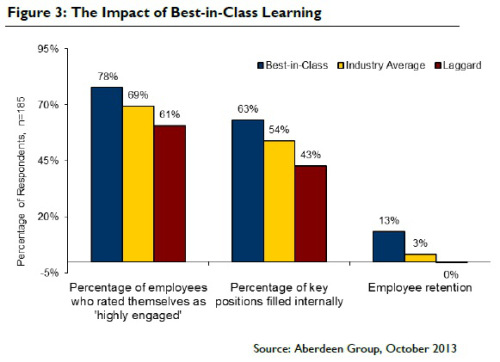“Learning is not a one-time experience but an ongoing process.”
This is one of the overarching ideas in a recent report written by Mollie Lombardi from the Aberdeen Group, which examines the business impact of organizations focus on learning programs.
The study is based on a collection of responses from 185 organizations and seeks to determine how organizations connect learning to business priorities, create development programs that impact every stage of the employee lifecycle, and utilize technology to support learning initiatives.
The study concludes that there is a definite correlation between organizational success and a high focus on learning initiatives.
Needed: leadership talent, critical skills
Let’s look at some of the specifics of this report…
Most HR professionals – as well as many other organization leaders – inherently recognize the importance of building/developing talent within, especially at a time when the economy is still recovering and our new generation of hires is consistently heralded as “lazy,” “entitled” or “unready” for the workforce.
It shouldn’t surprise us then that the No. 1 pressure driving learning initiatives in all organizations surveyed is the need for more leadership talent, with the No. 2 pressure driving learning initiatives coming from the lack of critical skills in the marketplace, which requires development from within. While I think the general negativity surrounding Millennials is misplaced, it is generally understood that a new college hire will require some training to become an effective member of the workforce.
According to Aberdeen’s research, 40 percent of organizations say that their college hires will require additional training and coaching, and 29 percent say they will have to spend significant time training and developing new college hires. It should surprise us then when we find out that only 19 percent of organizations have programs for new college hires and only 36 percent have dedicated leadership programs for emerging leaders.
A lack of training and development programs
These employee groups are effectively cited as the top two groups requiring training/development, so why the lack of programs in place to do this? The data clearly support that organizations understand the importance of focusing on learning programs, however, it also indicates that there are problems with organizations’ abilities to implement these programs.
We should use this disconnect to critically examine own our organizations and take a moment to reflect on the factors we know to be important (like learning initiatives). We may acknowledge the importance, even necessity, of such programs, but we should question whether this knowledge is actually being implemented or just internalized.
If there is disconnect between awareness and implementation, the question then becomes how to fix it. The data in this report suggests we look to what best in class organizations are doing, and in the case of learning initiatives, a few factors stand out.
Best in class organizations are 78 percent more focused than laggard organizations on providing a more consistent development experience at all career levels, and they are visibly less concerned than industry average or laggard organizations on more closely linking programs to business goals and defining /building a consistent set of competencies to guide development.
Linking programs to business goals
While these findings may be surprising at first glance, they may suggest that best in class organizations have already been able to link programs to business goals and develop a consistent set of competencies to guide development. This in turn has allowed them the freedom to focus more attention on having dedicated learning programs for individuals at all stages of the employee life cycle.
At a minimum, the data here can provide a broad set of steps for laggard and industry average organizations to follow in order to reap the benefit of learning initiatives. An added bonus of successfully instituted learning programs?
Organizations that use learning programs also see improved performance in employee engagement, their ability to fill leadership positions with internal candidates, and their ability to retain talent.
Getting with the program and focusing on the development of talent may seem obvious to you and me – but evidently not so much to many others.
This originally appeared on China Gorman’s blog at ChinaGorman.com.
